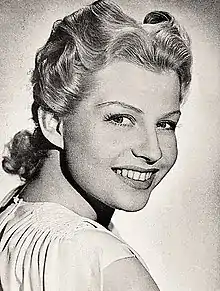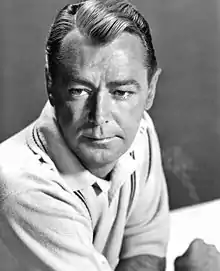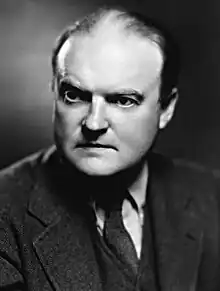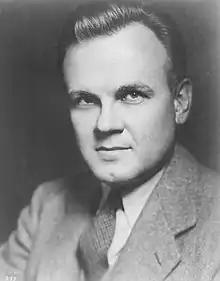| The Great Gatsby | |
|---|---|
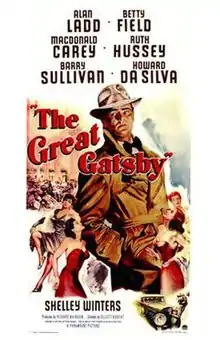 Original film poster | |
| Directed by | Elliott Nugent |
| Screenplay by | |
| Based on | The Great Gatsby by F. Scott Fitzgerald |
| Produced by | Richard Maibaum |
| Starring | |
| Cinematography | John F. Seitz |
| Edited by | Ellsworth Hoagland |
| Music by | Robert Emmett Dolan |
Production company | |
| Distributed by | Paramount Pictures |
Release date |
|
Running time | 91 minutes |
| Country | United States |
| Language | English |
| Box office | $2 million[1] |
The Great Gatsby is a 1949 American historical romance drama film directed by Elliott Nugent, and produced by Richard Maibaum, from a screenplay by Richard Maibaum and Cyril Hume. The film stars Alan Ladd, Betty Field, Macdonald Carey, Ruth Hussey, and Barry Sullivan, and features Shelley Winters and Howard Da Silva, the latter of whom later appeared in the 1974 version. It is based on the 1925 novel The Great Gatsby by F. Scott Fitzgerald. Set during the raucous Jazz Age on Long Island near New York City, the plot follows the exploits of enigmatic millionaire and bootlegger Jay Gatsby who attempts to win back the affections of his former lover Daisy Buchanan with the aid of her second cousin Nick Carraway.
In the 1940s, Paramount Pictures still held the rights to Fitzgerald's novel, having previously made the now-lost 1926 version. Producer Richard Maibaum became intent making a new film adaptation, and he envisioned Alan Ladd, with whom he previously collaborated on O.S.S. (1946), in the role of Gatsby. Although Maibaum and Ladd were eager to make the film, Paramount executives hesitated as the novel had not yet attained widespread popularity. Despite studio objections, Maibaum and Ladd persisted, and by 1946, Paramount announced plans for the film. However, production obstacles arose when Production Code Administration head Joseph Breen rejected the screenplay due to its perceived immorality.
The screenplay underwent multiple rewrites to appease the censors, including adding moralizing elements that deviated from Fitzgerald's 1925 novel. Maibaum reluctantly made these changes in his determination to see the film produced. Disagreements next arose between the original director John Farrow and Maibaum over the role of Daisy, with Farrow favoring Gene Tierney and Maibaum preferring Betty Field. This conflict led to Farrow's departure and his replacement by Elliott Nugent. Farrow's daughter, Mia Farrow, later starred as Daisy in the 1974 adaptation. The film's release garnered mixed reviews, with some praising the performances while others criticized the film for its deviations from the novel.
Plot
In 1948, a middle-aged Nick Carraway is married to Jordan Baker, and the happily married couple visit the grave of their deceased acquaintance Jay Gatsby. Carraway sermonizes that he did not approve of Gatsby's sinful life, and he quotes the Book of Proverbs condemning Gatsby's actions as wicked: "There is a way which seemeth right unto a man, but the end thereof are the ways of death."
A flashback occurs to 1928 during the tumultuous period of Prohibition in the United States. The enigmatic bootlegger Jay Gatsby is introduced after killing two rival gangsters in a street shootout. Gatsby hosts extravagant parties at his lavish Long Island Sound estate. He approaches his quiet neighbor, Nick Carraway, to organize a private tea with Nick's cousin, Daisy Buchanan. As it is revealed, Gatsby had been in love with Daisy before he left to serve in World War I.
Now a wealthy millionaire, Gatsby yearns to reunite with Daisy. However, she is married to the far wealthier Tom Buchanan. Despite her marriage, Daisy is discontented. She is aware of her husband's extramarital affair with Myrtle Wilson, who is married to George Wilson, the owner of a gas station. Daisy appears to appreciate Gatsby's advances. Together with Jordan Baker and Nick, they spend time in the city. Later, while Daisy is driving Gatsby's car, she accidentally strikes Myrtle in the street.
Returning home, Daisy confesses to Tom, Nick and Jordan that she killed Myrtle. Tom, Daisy and Jordan plot to blame Gatsby, but Nick objects and leaves. Gatsby overhears this discussion while standing unseen on the veranda. Wilson suspects that Tom killed his Myrtle, but he next suspects Gatsby. Tom tries to warn Gatsby that his life is danger, but he does not answer the telephone. While talking to Nick near his mansion's pool, Gatsby is shot by Wilson. Only Nick and Jordan attend Gatsby's funeral. The couple agree to marry and depart for the Midwest.
Cast
- Alan Ladd as Jay Gatsby
- Betty Field as Daisy Buchanan
- Macdonald Carey as Nick Carraway
- Ruth Hussey as Jordan Baker
- Barry Sullivan as Tom Buchanan
- Shelley Winters as Myrtle Wilson
- Howard Da Silva as George Wilson
- Elisha Cook, Jr. as Klipspringer
- Ed Begley as Myron Lupus
- Henry Hull as Dan Cody
- Walter Greaza as Kinsella
- Tito Vuolo as Mavromichaelis
- Jack Lambert as Reba
- Ray Teal as Cop (uncredited)
Production
Development
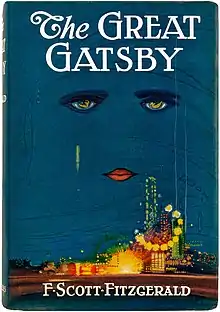
In 1926, Paramount Pictures paid $45,000 (equivalent to $743,853 in 2022) to purchase the film rights to F. Scott Fitzgerald's critically acclaimed yet commercially unsuccessful 1925 novel.[2] The studio produced the first film adaptation in November 1926 starring Warner Baxter as Jay Gatsby, Lois Wilson as Daisy Buchanan, and William Powell as George Wilson.[3] Two decades later, the studio still held the film rights to the novel.[4]
Paramount writer and producer Richard Maibaum—who had met F. Scott Fitzgerald during the author's brief sojourn in Hollywood[5]—became fixated on the idea of a new adaptation starring Oklahoma actor Alan Ladd as Jay Gatsby.[4] He had previously collaborated with Ladd on the 1946 film O.S.S., and the two had become close friends.[6] Maibaum presented the idea to Ladd and his wife, Sue.[7] While they initially had reservations, Maibaum recalled, "they liked it; they were a bit hesitant, but I persuaded them."[8] The role of Jay Gatsby intrigued Ladd since the character offered a departure from Ladd's typical action roles and allowed him a chance to demonstrate a broader acting range.[9]
Although Maibaum and Ladd wanted to make the film, Paramount executives proved hesitant to make this second film adaptation as Fitzgerald's beloved novel had not yet attained widespread popularity.[4] "This was in late 1946," Maibaum recalled. "Scott Fitzgerald had been dead since 1940. So it seemed, except in the hearts of a few devotees, were his out-of-print novels. His reputation was at its lowest ebb. The Jazz Age he celebrated was regarded as an aberration. But I saw a similarity between what was happening in 1946 to what had happened to the country in 1920 and, with Alan and Sue's help, kept badgering the studio until it agreed to let us prepare a script."[4]
Maibaum and Ladd persisted until Paramount executives relented and commissioned a screenplay.[4] Paramount publicly announced its plans to make the film starring Ladd in March 1946,[10] with the script to be written by Maibaum and Cyril Hume.[11] However, the mere idea of remaking The Great Gatsby soon ran afoul of the censors, in particular Production Code Administration head Joseph Breen.[4]
Screenplay
We were informed the script was totally unacceptable... Specifically, it violated the [Motion Picture Production] Code then in effect because it dealt with adultery, unpunished manslaughter, glamorized a gangster, depicted excessive use of liquor, undermined the institutions of marriage and the home, lowered moral standards, presented impure love as attractive and beautiful, etc, etc.
—Richard Maibaum, July 1973[4]
Censor Joseph Breen rejected the first draft of the screenplay by Richard Maibaum and Cyril Hume for having "a low moral tone."[4] He criticized their screenplay for its violations of the Motion Picture Production Code.[4] He specifically denounced their work for depicting adultery, excessive drinking, unpunished manslaughter, bootlegging, and other perceived moral transgressions.[4]
Breen insisted the screenplay be rewritten to avoid accurately evoking the libertine atmosphere of the Jazz Age.[4] Breen further demanded that the screenplay include a voice of morality and a lengthy preamble which outright condemned Gatsby's behavior as immoral.[4] Desperate to make the film, Maibaum capitulated to Breen's demands, although he later regretted doing so.[12]
Maibaum and Hume appeased the censors by altering plot details and by adding a scene at the beginning of the script where Nick Carraway, now married to Jordan Baker, quotes from Proverbs 14:12 that "there is a way which seemeth right unto a man, but the end thereof are the ways of death."[12] Having been forced to make these changes against his will, Maibaum felt such additions were "all wrong and very un-Fitzgerald-like. To moralize like that was something he never did; he was always indirect. It was the price I paid to get the film done."[13]
Despite rewrites by Maibaum and Hume, the censors still refused to greenlight the film.[14] After Breen's retirement, his successor Eric Johnston likewise proved reluctant to approve the film.[14] "The Johnston office seems to be afraid of starting a new jazz cycle," Maibaum told the press in 1946.[14] Due to the constant meddling by censors, critics later noted that film's script contained very little of "the flavor of the Prohibition era".[15] When censor Eric Johnston finally approved the bowdlerized script, Paramount greenlit the project in October 1947.[16] However, Maibaum claimed that Paramount delayed the film's production.[5] "They used the script as a carrot to make Alan do several other [lower quality] films, each time promising that his next would be Gatsby", wrote the producer. "Finally after two long years of this he rebelled and threatened to go on suspension. That did it."[5]
Casting
Paramount Pictures originally hired Australian émigré John Farrow, the husband of actress Maureen O'Sullivan and father of Mia Farrow, to direct the film.[7] Farrow had made a number of successful films with Ladd, as well as The Big Clock with Maibaum.[7] Farrow and Maibaum soon disagreed over the casting of Daisy Buchanan.[7] Maibaum recalled their intense disagreement in detail:
We were agreed that the character... was a beautiful, glamorous, unstable girl. Farrow however placed more importance on the glamour and beauty than I did. Hollywood was full of beautiful girls. I wanted more, an actress who could handle what has been called 'the disharmonic chatter of the '20s', the authentic sound of the feckless, disillusioned lost generation... What we needed was a fine actress who could make believable the obsessive love she evoked from him.[7]
Farrow wanted Gene Tierney, but Maibaum pushed for Betty Field.[7] Tiring of their impasse, studio production head Henry Ginsberg gave final say to Maibaum.[7] As a result, Farrow quit the film and told Maibaum: "I don't direct pictures under conditions like that. Find yourself another boy."[7] Farrow's daughter, Mia Farrow, later played Daisy Buchanan in the 1974 film adaptation.[7] With production imminent, Elliott Nugent replaced Farrow as director.[17][7] Although enthusiastic about casting Betty Field as Daisy Buchanan, Nugent had reservations about Alan Ladd as Jay Gatsby, although he kept these opinions from Maibaum.[7]
Filming
Director Elliott Nugent suffered from mental illness during the shoot.[9] According to Maibaum, Nugent had once went up onto the roof of the Hollywood Roosevelt Hotel and almost jumped off.[6] Throughout the shoot, Nugent proved to be indecisive which Maibaum attributed to his mental health difficulties.[4] In a June 1978 interview, Nugent spoke of his dissatisfaction with directing the film: "I felt very unhappy when I was making Gatsby. I thought I shouldn't be doing it and Alan Ladd shouldn't be playing in it. Ladd wasn't quite up to it, but he got away with it."[18]
Nugent primarily filmed the entire production indoors on a studio lot, including the exterior shots, to circumvent potential delays often associated with location shooting—such as changing sunlight, rain, or intrusive tourists.[18] Alan Ladd, who was at the pinnacle of his fame after returning from service in World War II, could not be taken on-location as he would invariably be "mobbed" in public appearances.[18] As a result, Nugent limited filming to the controlled, yet artificial environment of a brightly lit Hollywood sound stage, compromising visual authenticity and realism.[18]
Filming went smoothly, although Ladd refused to remove his wedding ring and also initially refused to kiss Field.[19] Ladd said that many of his fans were children and that he did not wish to play a character who kisses a married woman.[20] Ladd's Gatsby does kiss Field's Daisy on screen in a scene in the final film.[9] Despite these issues, Maibaum observed that Ladd seemed perfect for the role of Gatsby:
I was in [Ladd's] house and he took me up to the second floor, where he had a wardrobe about as long as this room. He opened it up and there must have been hundreds of suits, sport jackets, slacks and suits. He looked at me and said, "Not bad for an Okie kid, eh?" I got goose pimples because I remembered when Gatsby took Daisy to show her his mansion, he also showed her his wardrobe and said, "I've got a man in England who buys me clothes. He sends over a selection of things at the beginning of each season, spring and fall." I said to myself, "My God, he is the Great Gatsby!"[8]
Reception
Fitzgerald's friends
Fitzgerald's close friend and literary critic Edmund Wilson, who had known Fitzgerald since their days as classmates at Princeton University, disliked the film.[21] As Wilson had played a pivotal role in creating the F. Scott Fitzgerald revival in the 1940s,[22][23] Paramount Pictures arranged a private screening of the film for Wilson in the hopes of earning his public endorsement.[21]
According to witness Stanley Kauffmann, as Wilson exited the screening room, a smiling Paramount publicity man approached Wilson and asked him how he had liked the picture.[21] "Not very much, I'm afraid," replied Wilson, and he kept walking to the elevator.[21] The Paramount publicity man appeared to be betrayed by Wilson's reply and seemed to say, "We've gone to the trouble of making a whole movie out of your friend's book and you don't even appreciate it!"[21]
Contemporary reviews
Most of the tragic implications and bitter ironies of Mr. Fitzgerald's work have gone by the boards in allowing for the generous exhibition of Mr. Ladd. Solemnly representing Gatsby, he gives us a long and lingering look at a patient and saturnine fellow who is plagued by a desperate love.... But somehow he does not present us with the picture of a strangely self-made man as the pitiful victim of the times and his own expansive greed.... Blame this mostly on a weak script, coupled with dull direction.
—Bosley Crowther, The New York Times, July 14, 1949[15]
According to Variety, the film ranked 45th among popular movies in the U.S. and Canada in 1949.[1] Maibaum claimed the film "did well financially although reviews were mixed. Critics differed as much as John Farrow and myself about Betty Field's Daisy. Some thought she was perfect, others that she was subtly wrong. Alan, for the most part, received surprisingly good personal notices. My own satisfaction stemmed from what Charles Brackett of sainted memory to all screenwriters said to me: 'You've personally started an F. Scott Fitzgerald revival'."[9]
The New York Times' review by Bosley Crowther dismissed the film as "a limp, sentimental romance, involving a bootlegger and an old sweetheart, based on Scott Fitzgerald's classic story, but lacking the novel's bite."[24] Crowther lamented that "the period of the Nineteen Twenties is briefly and inadequately sketched with a jumble of gay Long Island parties, old clothes, old songs and old cars. The baneful influence of prohibition and the disillusionment of post-World War I" were conspicuously absent despite the Jazz Age setting.[15] Crowther felt that Ladd was too solemn as Gatsby and gave the impression of "a patient and saturnine fellow who is plagued by a desperate love".[15]
Critics expressed conflicted opinions about Betty Field's performance as Daisy.[9] Critic Lew Sheaffer wrote in The Brooklyn Daily Eagle that Field performed "the difficult feat of making a strong impact" as Gatsby's "vague, shilly-shallying sweetheart."[25] Boyd Martin of The Courier-Journal opined that Field was "convincing in showing the shallowness of Daisy's character",[26] whereas Wanda Hale of The New York Daily News complained that Field gave "such a restrained, delicate performance that you have to use some imagination to understand her weakness."[27]
Critic Lew Sheaffer wrote in The Brooklyn Daily Eagle that Macdonald Carey acquitted himself well as Nick Carraway, Gatsby's only friend.[25] Likewise, Boyd Martin of The Courier-Journal opined that Carey gave a quiet and reserved performance.[26]
Retrospective reviews
According to film scholar Wheeler Winston Dixon, the 1949 version of The Great Gatsby is "a curiously tedious, flat, and unimaginative film, lacking both visual and thematic resonance."[18] Dixon posits that the film's shortcomings primarily stem from Elliott Nugent's uninspired direction, accentuated by an overly wordy and meandering screenplay.[18] As a result, the film appears to lack a cohesive vision, both visually and thematically.[18]
Restoration
In 2012, Universal Pictures released a new print of the 1949 film.[28]
References
Citations
- 1 2 Variety 1950, p. 59.
- ↑ Tredell 2007, pp. 93–96.
- ↑ Dixon 2003; Howell 2013; Hischak 2012, pp. 85–86.
- 1 2 3 4 5 6 7 8 9 10 11 12 13 Maibaum 1973, p. 39.
- 1 2 3 Maibaum 1973, p. 41.
- 1 2 Maibaum 1973, p. 38.
- 1 2 3 4 5 6 7 8 9 10 11 Maibaum 1973, p. 14.
- 1 2 McGalligan 1986, p. 280.
- 1 2 3 4 5 Maibaum 1973, pp. 14, 38.
- ↑ The Mail 1946, p. 9.
- ↑ The New York Times 1946, p. 31.
- 1 2 Maibaum 1973, pp. 39, 41.
- ↑ McGalligan 1986, pp. 281–282.
- 1 2 3 Brady 1946, pp. 65, 67.
- 1 2 3 4 Crowther 1949, p. 20.
- ↑ Weiler 1947, p. X5.
- ↑ Brady 1948, p. 26.
- 1 2 3 4 5 6 7 Dixon 2003.
- ↑ Maibaum 1973, pp. 39, 42.
- ↑ Maibaum 1973, p. 42.
- 1 2 3 4 5 Kauffmann 1974.
- ↑ Mizener 1960.
- ↑ Verghis 2013.
- ↑ The New York Times 1949, p. 188.
- 1 2 Sheaffer 1949, p. 4.
- 1 2 Martin 1949, p. 36.
- ↑ Hale 1949, p. 38.
- ↑ Music Box Theatre 2012, p. 29.
Works cited
- Brady, Thomas F. (October 13, 1946). "Alarum in Hollywood". The New York Times (Sunday ed.). New York City. pp. 65, 67. Retrieved October 31, 2023.
The Production Code Administration has strongly urged complete abandonment of the story because of its 'low moral tone.' [...] 'The Johnston office', Maibaum says, 'seems to be afraid of starting a new jazz cycle.'
- Brady, Thomas F. (February 13, 1948). "Nugent Replaces Farrow On Movie: Named by Paramount to Direct 'The Great Gatsby,' Remake of Fitzgerald Novel". The New York Times (Friday ed.). New York City. p. 26. Retrieved October 31, 2023.
- Crowther, Bosley (July 14, 1949). "The Screen In Review: 'The Great Gatsby,' Based on Novel of F. Scott Fitzgerald, Opens at the Paramount". The New York Times (Thursday ed.). New York City. p. 20. Retrieved October 31, 2023.
- Dixon, Wheeler Winston (2003). "The Three Film Versions of The Great Gatsby: A Vision Deferred". Literature-Film Quarterly. Salisbury, Maryland. 31 (4): 287–294. Archived from the original on October 13, 2013. Retrieved October 11, 2013.
- Hale, Wanda (July 14, 1949). "Smooth Cast Joins Ladd in 'Great Gatsby'". New York Daily News (Thursday ed.). New York City. p. 38. Retrieved October 31, 2023 – via Newspapers.com.
- Hischak, Thomas S. (2012). American Literature on Stage and Screen: 525 Works and Their Adaptations. Jefferson, North Carolina: McFarland & Company. pp. 85–86. ISBN 978-0-7864-6842-3. Archived from the original on March 10, 2021. Retrieved November 3, 2023 – via Google Books.
- Howell, Peter (May 5, 2013). "Five Things You Didn't Know About The Great Gatsby". The Star. Toronto, Canada. Archived from the original on May 7, 2013. Retrieved November 3, 2023.
- "Just a Line From Hollywood". The Mail (Saturday ed.). Adelaide, Australia. March 9, 1946. p. 9. Retrieved November 10, 2023 – via National Library of Australia.
- Kauffmann, Stanley (April 13, 1974). "TNR Film Classics: The Great Gatsby". The New Republic. Washington, D.C. Archived from the original on May 5, 2019. Retrieved November 10, 2023.
- Maibaum, Richard (July 15, 1973). "'Great Gatsby' Employs Two Generations of Farrows: 'Gatsby' Employs Farrow Family". Los Angeles Times (Sunday ed.). Los Angeles, California. pp. 14, 38–39, 41–42. Retrieved October 31, 2023 – via Newspapers.com.
- Martin, Boyd (July 29, 1949). "Alan Ladd, as 'Great Gatsby,' Finds That Money is a False God". The Courier-Journal (Friday ed.). Louisville, Kentucky. p. 36. Retrieved October 31, 2023 – via Newspapers.com.
- Mizener, Arthur (April 24, 1960). "Gatsby, 35 Years Later". The New York Times. New York City. Archived from the original on November 19, 2021. Retrieved November 10, 2023.
- McGalligan, Pat, ed. (1986). "Richard Maibaum: A Pretense of Seriousness". Backstory: Interviews with Screenwriters of Hollywood's Golden Age. Los Angeles: University of California Press. pp. 266–289. ISBN 0-520-05666-3 – via Internet Archive.
- "Music Box Calendar" (PDF). Music Box Theatre. Chicago. August 2012. p. 29. Archived from the original (PDF) on June 16, 2012. Retrieved October 31, 2023.
- "Pat O'Brien to Star In 'The Big Angle': Crime Drama Was Written by Author of 'Bombardier' — 'Gatsby' to Be Remade". The New York Times (Tuesday ed.). New York City. February 26, 1946. p. 31. Retrieved October 31, 2023.
- "Review in Brief". The New York Times (Sunday ed.). New York City. July 17, 1949. p. 188. Retrieved October 31, 2023.
- Sheaffer, Lew (July 14, 1949). "'Great Gatsby' Expertly Catches Restless Spirit of the Jazz Age". The Brooklyn Eagle (Thursday ed.). Brooklyn, New York. p. 4. Retrieved October 31, 2023 – via Newspapers.com.
- "Top Grossers of 1949". Variety (Wednesday ed.). New York. January 4, 1950. p. 59. Retrieved October 31, 2023 – via Internet Archive.
- Tredell, Nicolas (February 28, 2007). Fitzgerald's The Great Gatsby: A Reader's Guide. London: Continuum Publishing. ISBN 978-0-8264-9010-0. Retrieved November 13, 2023 – via Internet Archive.
- Verghis, Sharon (May 3, 2013). "Careless People of F. Scott Fitzgerald's Great Gatsby Have a Modern Equivalent". The Australian. Surry Hills, New South Wales. Archived from the original on March 25, 2017. Retrieved November 10, 2023.
- Weiler, A. H. (October 26, 1947). "Notes About Pictures and People: New York to Get Another Film Unit — Ticket Tax Cut Asked". The New York Times (Sunday ed.). New York City. p. X5. Retrieved October 31, 2023.

